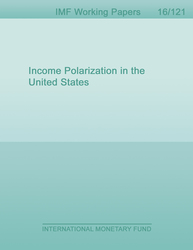
Income Polarization in the United States
The paper uses a combination of micro-level datasets to document the rise of income polarization—what some have referred to as the "hollowing out" of the income distribution—in the United States, since the 1970s. While in the initial decades more middle-income households moved up, rather than down, the income ladder, since the turn of the current century, most of polarization has been towards lower incomes. This result is striking and in contrast with findings of other recent contributions. In addition, the paper finds evidence that, after conditioning on income and household characteristics, the marginal propensity to consume from permanent changes in income has somewhat fallen in recent years. We assess the potential impacts of these trends on private consumption. During 1998-2013, the rise in income polarization and lower marginal propensity to consume have suppressed the level of real consumption at the aggregate level, by about 3½ percent—equivalent to more than one year of consumption.
Publication date: June 2016
ISBN: 9781475522501
$18.00
Add to Cart by clicking price of the language and format you'd like to purchase
Available Languages and Formats
| English |
Prices in red indicate formats that are not yet available but are forthcoming.
Topics covered in this book
This title contains information about the following subjects.
Click on a subject if you would like to see other titles with the same subjects.
Economics- Macroeconomics , Economics- Macroeconomics , Economics / General , Economics / General , International - Economics , International - Economics , Middle Class , Middle-Income Class , Income Polarization , Hollowing Out of the Middle Class , Inequality , Marginal Propensity to Consume
Summary
Copyright © 2010 - 2024
Powered by:
AIDC



